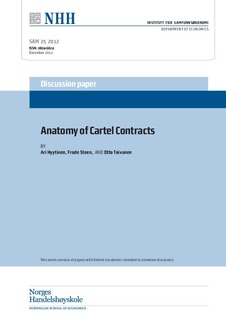| dc.contributor.author | Hyytinen, Ari | |
| dc.contributor.author | Steen, Frode | |
| dc.contributor.author | Toivanen, Otto | |
| dc.date.accessioned | 2013-03-13T11:24:46Z | |
| dc.date.available | 2013-03-13T11:24:46Z | |
| dc.date.issued | 2012-12 | |
| dc.identifier.issn | 0804-6824 | |
| dc.identifier.uri | http://hdl.handle.net/11250/163424 | |
| dc.description.abstract | We study cartel contracts using data on 18 contract clauses of 109 legal Finnish manufacturing
cartels. One third of the clauses relate to raising profits; the others deal with
instability through incentive compatibility, cartel organization, or external threats. Cartels
use three main approaches to raise profits: Price, market allocation, and specialization.
These appear to be substitutes. Choosing one has implications on how cartels deal
with instability. Simplifying, we find that large cartels agree on prices, cartels in homogenous
goods industries allocate markets, and small cartels avoid competition
through specialization. | no_NO |
| dc.language.iso | eng | no_NO |
| dc.publisher | Norwegian School of Economics, Department of Economics | no_NO |
| dc.relation.ispartofseries | Discussion paper;25/2012 | |
| dc.subject | cartels | no_NO |
| dc.subject | contracts | no_NO |
| dc.subject | antitrust | no_NO |
| dc.subject | competition policy | no_NO |
| dc.subject | industry heterogeneity | no_NO |
| dc.title | Anatomy of cartel contracts | no_NO |
| dc.type | Working paper | no_NO |
| dc.subject.nsi | VDP::Social science: 200::Economics: 210::Economics: 212 | no_NO |
